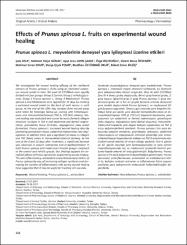| dc.contributor.author | Ayla, Şule | |
| dc.contributor.author | Günal, Mehmet Yalçın | |
| dc.contributor.author | Sayın Şakul, Ayşe Arzu | |
| dc.contributor.author | Biçeroğlu, Özge | |
| dc.contributor.author | Özdemir, Ekrem Musa | |
| dc.contributor.author | Okur, Mehmet Evren | |
| dc.contributor.author | Polat, Derya Çiçek | |
| dc.contributor.author | Üstündağ Okur, Neslihan | |
| dc.contributor.author | Bilgiç, Bülent Emre | |
| dc.date.accessioned | 08.07.201910:49:13 | |
| dc.date.accessioned | 2019-07-08T20:18:30Z | |
| dc.date.available | 08.07.201910:49:13 | |
| dc.date.available | 2019-07-08T20:18:30Z | |
| dc.date.issued | 2017 | en_US |
| dc.identifier.citation | Ayla, Ş., Günal, M. Y., Sayın Şakul, A. A., Biçeroğlu, Ö., Özdemir, E. M. ve Okur, M. E. (2017). Prunus spinosa L. meyvelerinin deneysel yara iyileşmesi üzerine etkileri. Medeniyet Medical Journal, 32(3), 152-158. https://dx.doi.org/10.5222/MMJ.2017.152 | en_US |
| dc.identifier.issn | 2149-2042 | |
| dc.identifier.issn | 2149-4606 | |
| dc.identifier.uri | https://hdl.handle.net/20.500.12511/320 | |
| dc.description.abstract | Farelerde oluşturduğumuz deneysel yara modellerinde, Prunus Spinosa L. metanollü meyve ekstresini kullanarak, bu ekstrenin yara iyileşmesindeki etkisini araştırdık. Otuz iki adet C57/Black fare ile 4 deney grubu oluşturuldu. Birinci grup kontrol grubu, 2. grup taşıyıcı (gliserin) grup, 3. grup Prunus spinosa, 4. grup ma- decassol grubu idi ve her bir grupta farelerin sırtında eksizyonel yara modeli oluşturularak Prunus Spinosa L. ve madecassol 10. gün boyunca uygulandı. Onuncu gün sonunda yara bölgeleri his- tolojik takip için alındı, yara dokuları hematoksilen-eosin ve im- munohistokimyasal (TGF-?, COL1A1) boyalarla boyanarak, yara iyileşmesi için epidermal ve dermal rejenerasyon, granülasyon doku oluşumu, anjiogenezis (yeni damar oluşumu), immunohis- tokimyasal boyalarla yeni oluşan kollajen yapılanması ve TGF ? artışı değerlendirilerek skorlandı. Prunus spinosa L’nin yara do- kusunda iyileşme oranlarını, granülasyon dokusunu, epidermal rejenerasyonu ve anjiogenezisi artırarak gösterdiği yine immü- nohistokimyasal boyamalarda kollajen ve TGF ? oranlarında ista- tistiksel olarak anlamlı bir artışın olduğu gözlendi. Yine 4. günün ve 10. günün sonunda yara kontraksiyonunda ve yara yerinin reepitelizasyonunda ilaç ve madecassol grubunda kontrol gru- buna kıyasla anlamlı bir artış gözlenmiştir. Bulgularımız, Prunus spinosa L’nin yara iyileşmesini desteklediğini göstermiştir. Prunus spinosanın antiinflamatuvar, antioksidan ve antibakteriyel etki- si ile, kollajen sentezini artırarak ve inflamatuvar hücre sayısını azaltarak yara iyileşmesinin tedavisinde kullanılabileceğini dü- şündürdü. | en_US |
| dc.description.abstract | We investigated the wound healing efficacy of the methanol extracts of Prunus spinosa L. fruits using an excisional cutane- ous wound model in mice. We used 32 C57/Black mice equally divided into four groups. Group 1 Control, Group 2 vehicle (glyce- rine), Group 3 Prunus spinosa L., Group 4 Madecassol. Prunus spinosa L.and Madecassol were applied for 10 days by creating a excisional wound model on the back of each mouse in each group. At the end of the 10th day, samples from wound areas were taken for histologic follow-up, scoring with hematoxylin- eosin and immunohistochemical (TGF-b, COL1A1) staining. Wo- und healing was evaluated and scored by newly formed collagen structure, increase in TGF b and epidermal and dermal regene- ration, granulation tissue thickness, angiogenesis (new vessel formation). Prunus spinosa L. increased wound healing rates by promoting granulation tissue, epidermal regeneration and angi- ogenesis. In addition there was a significant increase in collagen and TGF [beta] ratios in immunohistochemical staining. At the end of the 4 and 10 days after treatment, a significant increase was observed in wound contraction and re-epithelialization in both Prunus spinosa and madecassol treated groups compared to the control and vehicle groups. Our findings support the be- neficial effects of Prunus spinosa for augmenting wound healing. The anti-inflammatory, antioxidant and antibacterial activities of Prunus spinosa by way of increasing collagen synthesis and dec- reasing the number of inflammatory cells during wound healing have suggested that it may be useful for treating skin wounds. | en_US |
| dc.language.iso | tur | en_US |
| dc.rights | info:eu-repo/semantics/openAccess | en_US |
| dc.subject | Yara İyileşmesi | en_US |
| dc.subject | Prunus Spinosa L. | en_US |
| dc.subject | Antioksidan | en_US |
| dc.subject | Wound Healing | en_US |
| dc.subject | Prunus Spinosa L. | en_US |
| dc.subject | Antioxidant | en_US |
| dc.title | Prunus spinosa L. meyvelerinin deneysel yara iyileşmesi üzerine etkileri | en_US |
| dc.title.alternative | Effects of prunus spinosa L. fruits on experimental wound healing | en_US |
| dc.type | article | en_US |
| dc.relation.ispartof | Medeniyet Medical Journal | en_US |
| dc.department | İstanbul Medipol Üniversitesi, Tıp Fakültesi, Temel Tıp Bilimleri Bölümü, Histoloji ve Embriyoloji Ana Bilim Dalı | en_US |
| dc.department | İstanbul Medipol Üniversitesi, Tıp Fakültesi, Dahili Tıp Bilimleri Bölümü, Tıbbi Farmakoloji Ana Bilim Dalı | en_US |
| dc.department | İstanbul Medipol Üniversitesi, Rektörlük, Rejeneratif ve Restoratif Tıp Araştırmaları Merkezi (REMER) | en_US |
| dc.department | İstanbul Medipol Üniversitesi, Eczacılık Fakültesi, Eczacılık Teknolojisi Bölümü, Farmasötik Teknoloji Ana Bilim Dalı | en_US |
| dc.authorid | 0000-0003-2143-5268 | en_US |
| dc.authorid | 0000-0001-9416-7757 | en_US |
| dc.authorid | 0000-0002-3210-3747 | en_US |
| dc.identifier.volume | 32 | en_US |
| dc.identifier.issue | 3 | en_US |
| dc.identifier.startpage | 152 | en_US |
| dc.identifier.endpage | 158 | en_US |
| dc.relation.publicationcategory | Makale - Uluslararası Hakemli Dergi - Kurum Öğretim Elemanı | en_US |


















